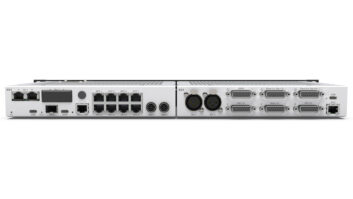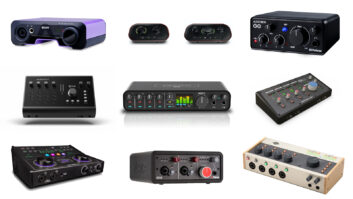
MOTU 1248
MOTU in Cambridge, Mass., announces three new Thunderbolt audio interfaces—the 1248, 8M and 16A ($1,495 each)—with complementary I/O configurations, AD/DA conversion with very high dynamic range, 48-channel mixing, DSP effects and AVB Ethernet audio networking for system expansion. Based on a new, shared technology platform, the 1248, 8M and 16A differ only in their analog I/O configurations.
As the most versatile of the three, the flagship 1248 offers 8×12 balanced TRS analog I/O, four mic inputs with digitally-controlled individual preamps, two front-panel hi-Z guitar inputs, two independent phone outs and stereo RCA S/PDIF digital I/O.

MOTU 8M
The 8M provides eight balanced TRS analog outputs, plus eight mic/line/instrument “combo” style inputs individually equipped with digitally controlled preamps, 48-volt phantom power, pad and MOTU’s hardware-based V-Limit overload protection.
The 16A is packed with 32 balanced TRS analog connections (16 inputs and 16 outputs). All three units provide two banks of optical digital I/O, word clock I/O and computer connectivity through either audio class compliant USB 2 or Thunderbolt (1 and 2 compatible).
MOTU has equipped these units with the latest-generation ESS Sabre32 Ultra converters, and engineered analog performance for the most demanding listening situations. For example, the balanced TRS analog outputs provide a measured dynamic range of 123 dB (A-weighted, 20 Hz to 20 kHz). Analog I/O latency is said to be very low, with a round-trip performance of 32 samples (0.66 ms) at 48 kHz. Each unit provides comprehensive metering for all inputs and outputs on a large, backlit 324×24 pixel LCD.

MOTU 16A
The 1248, 8M and 16A are equipped with latest-generation DSPs that drive a 48-channel mixer designed after large format mixing consoles. With 32-bit floating point precision, the mixer’s 48 inputs can take signal from the physical inputs on the interface itself, audio channels from host software on the computer, audio network streams and mixer outputs. The mixer provides seven stereo aux buses, three groups, a reverb bus that can alternately serve as a fourth group, a Main Mix bus and a separate Monitor bus that doubles a solo bus. Effects include classic reverb, 4-band modeled analog EQ, modeled vintage compression and gating. A flexible matrix routing grid makes it easy for users to route audio to and from the mixer, the computer and audio network streams, including the ability to split a single input (or input pair) to multiple destinations.
All three interfaces are equipped with a single AVB Ethernet network port. Developed by the IEEE, the 802.1 Audio Video Bridging (AVB) extension to the Ethernet standard has been engineered to deliver reliable, scalable, low-latency, high-bandwidth audio networking. Users can add a second MOTU interface to a system with a simple Cat-5e Ethernet cable or build a system of three to five interfaces connected to the 5-port, 1-Gigabit MOTU AVB Switch (sold separately for $295). No special IT expertise or network configuration is required, as AVB is designed to be plug-and-play.
By daisy-chaining additional MOTU switches (or third-party AVB switches), large-scale networks can be installed in multi-room studios, performance venues, houses of worship, university music departments and other similar facilities, using existing Ethernet cabling infrastructure and cable runs up to 100 meters (328 feet) between devices and switches. Multiple computers can be connected throughout the network, and all devices and computers on the network can route audio to and from all others.
Each MOTU interface on an AVB network, or any computer connected through Thunderbolt, can simultaneously send and receive 128 channels of network audio I/O. A MOTU AVB network supports over 512 audio channels, and point-to-point network latency is fixed at only 30 samples (0.625 ms), even over multiple switches, when operating the system at 48 kHz. AVB provides unified, system-wide, precision clocking and synchronization that is measured in nanoseconds. Users can simply click the “Become Clock Master” button in the control software to immediately resolve all devices on the network to the chosen master device.
Find information about the MOTU 1248.
Find information about the MOTU 8M.







